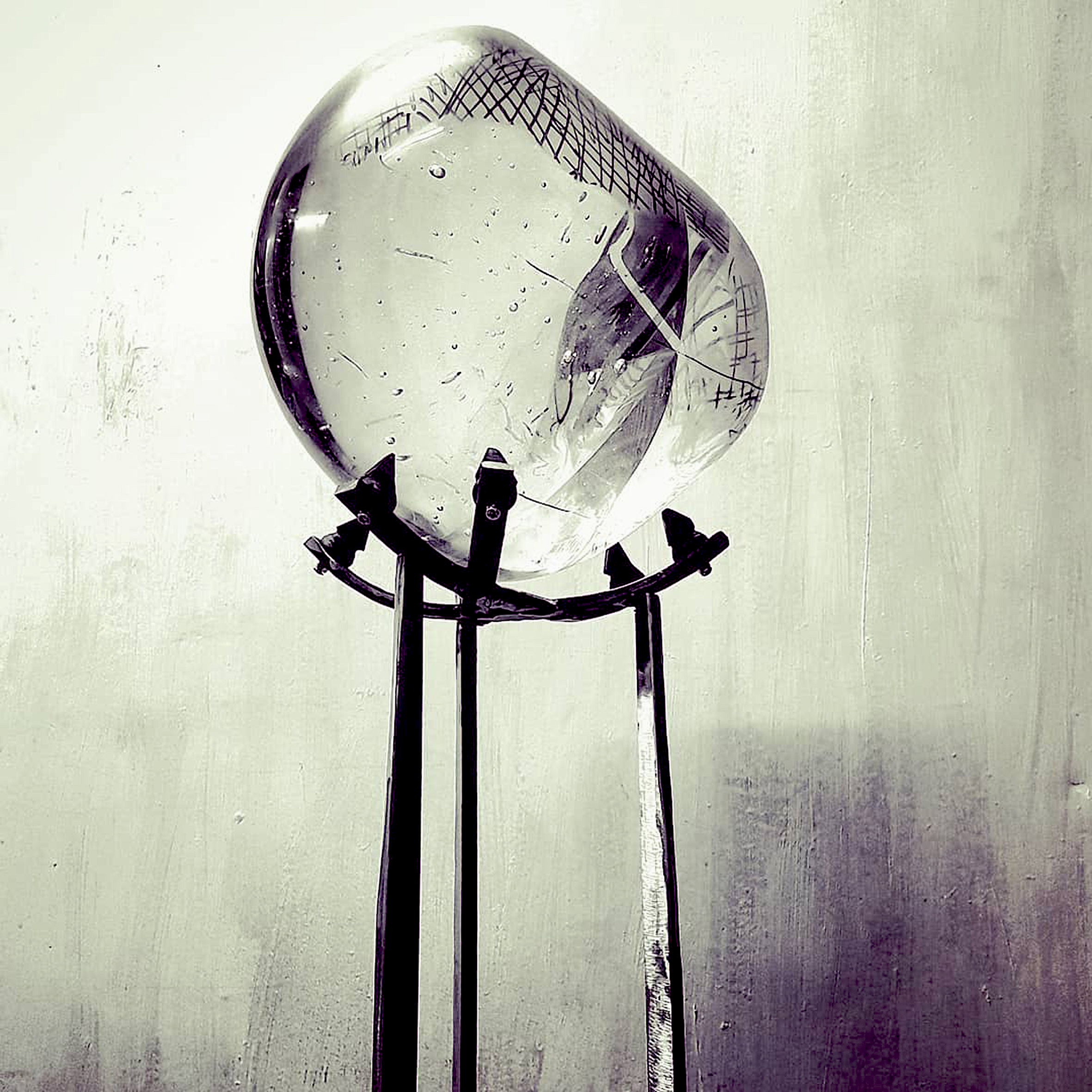Jon Lewis | Tuned to a Single Frequency by Dr. Julie Anne Denton for Glass Art Magazine
11th July 2023
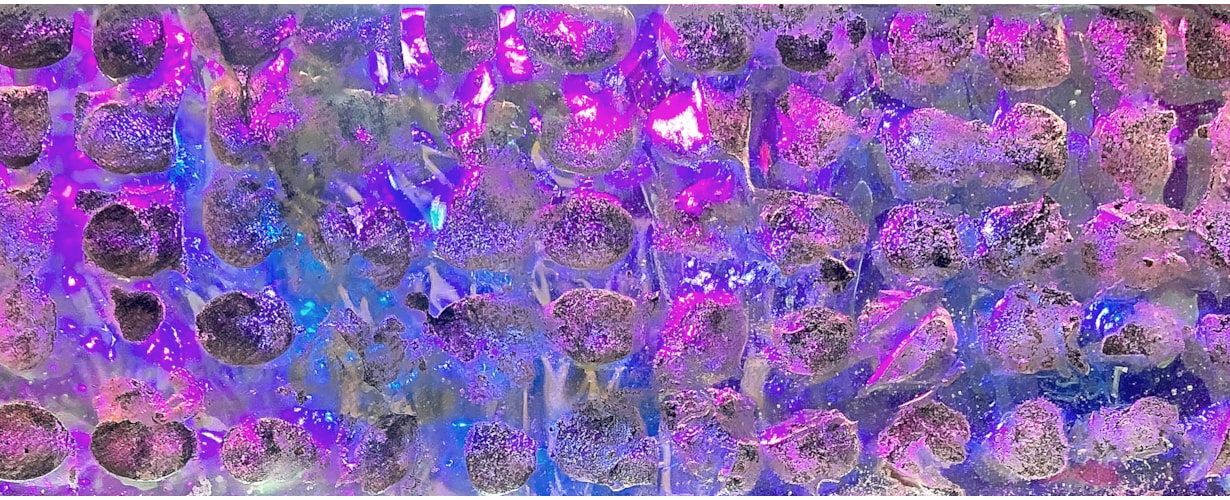
Jon Lewis | Tuned to a Single Frequency
By Dr. Julie Anne Denton for Glass Art Magazine Jan/Feb 2023
Shy and handsome, multidisciplinary maverick glassmaker Jon Lewis works from a reappropriated flour mill in Essex at a gallery complex 30 miles from the centre of London called Parndon Mill. When it comes to materials and the science behind them, Jon is in his element. His artwork emerges from his earthly experimentation, and his work takes on an otherworldly feel that is reminiscent of relics from an antiquated, alien plane somewhere far, far away from the here and now.
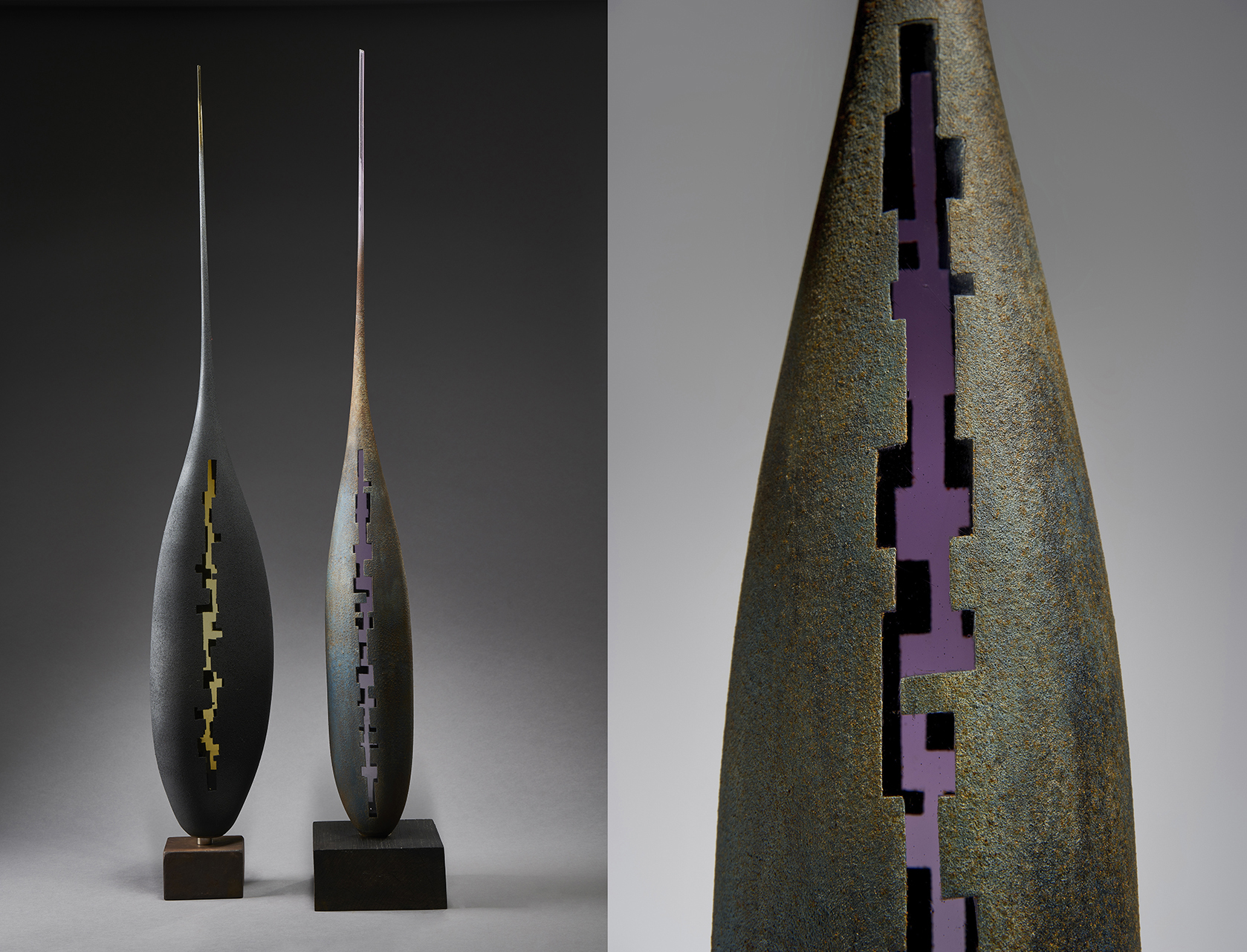
Strange Attractor
2019 | H 90cm x W 40xm x D 16cm | Recycled blown glass television screens, cold carved, spark impregnated with iron, patinated. Wood base | Photo by Matthew Booth
To get to know Jon Lewis better, a little history is called for. “I was born up in the Malvern Hills, in the centre of England to the West.” The region surrounding Malvern is famous in the UK, not only because it is a designated area of outstanding natural beauty, but also the Highlands, made of granite and limestone, have deep fissures in them that retain rainwater. The precipitation slowly percolates through the rock and emerges as springs between the strata.
The health benefits of this water have been reported for over four centuries. Beginning with Queen Elizabeth I, this water has been bottled and drunk by many English monarchs. “This area is rural, and from a young age I was exposed to nature, construction, and motorbikes. At 18, I left Worcestershire to study electronics, engineering, and computing, but after a few years of study I contracted glandular fever. This illness put a stop to everything for a short time. As I was recovering, I realized I wanted to create a portfolio and attend art college.”
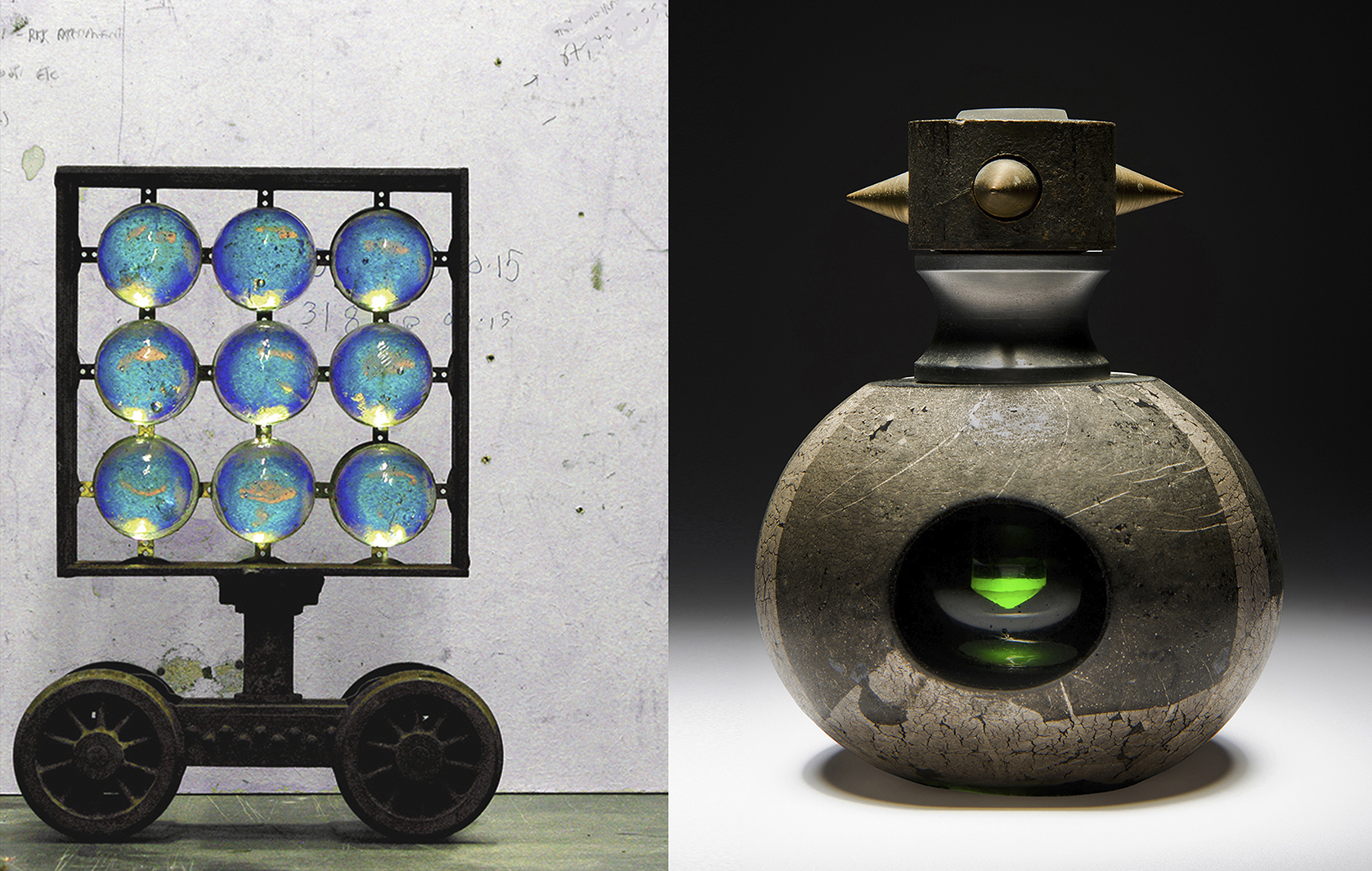
Above left:
Vehicle
2010 | H 23cm x W 20cm x D 11cm | Hot cast glass components, polished with interference filter, 3.5 inch gauge steam locomotive adapted rolling chassis | Photo by Jon Lewis
Above right:
Alchemy Bottle
2014 | H 12cm x W 10cm x D 10cm | Blown glass coated in iron, patinated, turned steel, aluminium and brass stopper with dichroic glass dropper | Photo by Ester Segarra
Interference Filter
In 1989, Jon Lewis was one of the first sets of students to attend the University of Wolverhampton’s all-new glass programme, which in the 1990s was arguably considered to be the best bachelor’s course in Europe. “I attended Wolves for two years, then I took a year out to hone my glassblowing skills at the technical college in Brierly Hill, deep in the centre of the Black Country. The myth goes that when riding through middle England on the Royal train, Queen Victoria requested of her butler, ‘Close the curtains. I don’t want to see that Black Country.’ The reality is a little more tame. During the Industrial Revolution, 1760 onwards, the canal system gave rise to a surge in industry in the West Midlands that produced a high level of air pollution, hence the name.
“After finishing my year at the International Glass Centre, I returned to Wolverhampton to finish my degree. I was surrounded by fantastic classmates and the best tutors, including Professor Keith Cummings (kiln casting) and the late Stuart Garfoot (centrifuged glass). After university, I worked as a glass technician for a different university for one year. Thereafter, an opportunity came up in Oregon to work as a glassmaker’s assistant, and I lived stateside for six months.”
Upon Jon’s return to the UK, he worked on stained glass commissions for a few years in London. Later he worked for a glassworks in Shoreditch and eventually set up his own business, Flux Glass, with colleague Max Lamb. This incarnation created high-end production for house and home. The first thing they did together as designer/makers was to exhibit at the New York International Gift Fair in unison with the British Craft Council. After this successful show, they worked on numerous glass projects together. In 2005, Jon decided he wanted to concentrate on his own work and personal commissions, so he rented a new studio in Hackney, London.
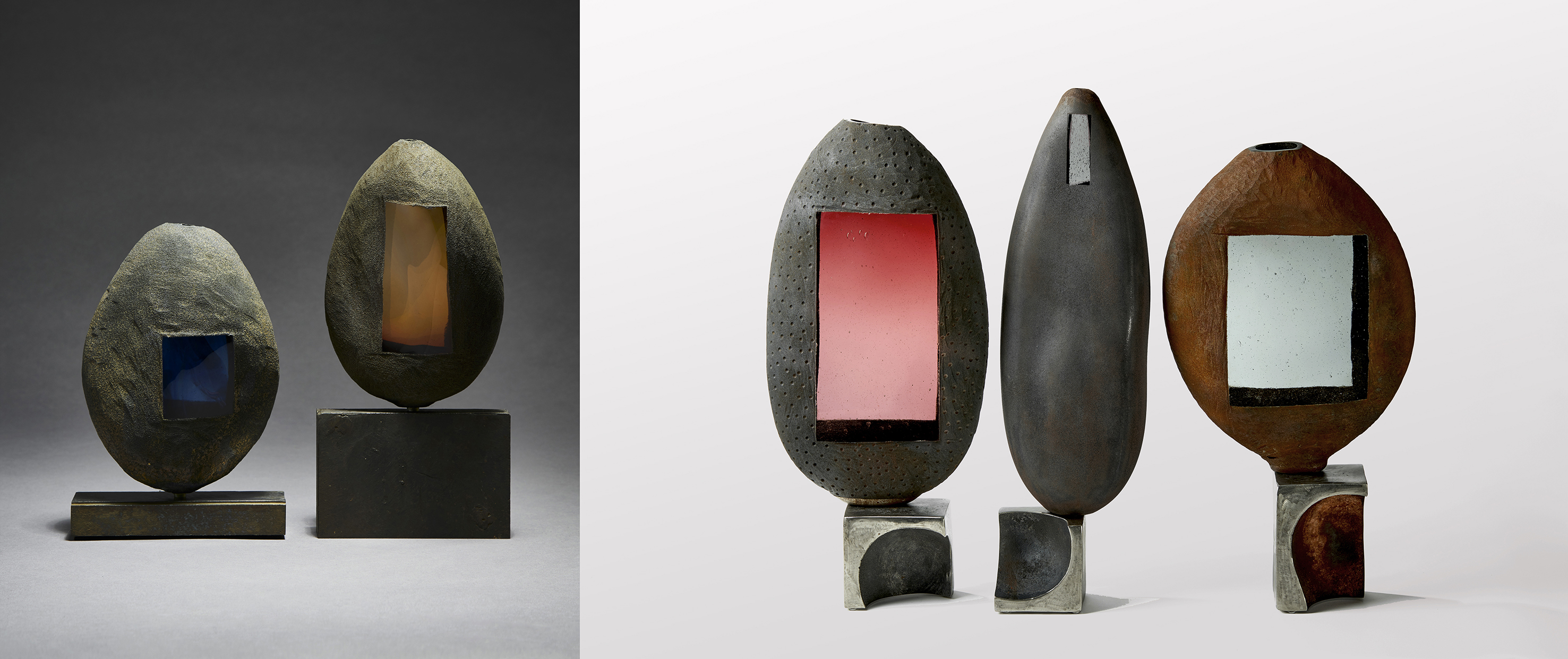
Above left:
Twin Apertura
2020 | H 20cm x W 22cm x D 10cm | Recycled blown glass television screens, cold carved, spark impregnated with iron, patinated, steel bases | Photo by Matthew Booth
Above right:
Apertura Series
2022 | H 40cm x W 75cm x D 20cm | Recycled blown glass television screens, cold carved, spark impregnated with patinated iron, cast iron bases | Photo by Agata Pec
Light Circulating
Rather than creating production after disbanding Flux Glass, Jon concentrated on making architectural work in glass. As time went on, the commissions he applied for got bigger and bigger. He was awarded a rather prestigious commission at that time by the government of Egypt. “I guess you would call them two-and-a-half-meter dichroic mirror balls, made up of 120,000 dichroic tiles per piece. Dichroic is an interference filter on glass that shimmers in a similar way to dragonfly wings. Space Pyramidion was eventually displayed in Cairo, towering sixty feet above the ground.”
This commission was realized during the 2011 Egyptian Revolution, which was a time of great civil unrest in Egypt, calling for the end of the Mubarak regime. A new leader, Mohamed Morsi was fairly elected in 2012, although that did not solve the problems in the country. “These mirror balls were originally commissioned by Suzanne Mubarak, the then President Hosni Mubarak’s wife, but by the time I arrived to realize the commission, Mubarak had resigned. During this period of unrest, I was taking my lead from the military junta, government led by military leaders, when I completed the project. In a positive turn of events the artworks became disassociated from Mubarak, and the pieces were permanently suspended in the Child Creativity Museum in Cairo. In 2012, they won the International Museum category at the Museums and Heritage Awards, London 2012, I am proud to say.”
Upon completion of the Egypt project, Jon was invited to show his work in a glass exhibition in the UK. “I drove up to Essex from London, and as I crossed the bridge, I beheld the Parndon Mill and an overwhelming desire to move my studio to this verdant area overcame me. As luck would have it, the gallery was actively looking for a resident glassblower, and fortune shone on me. A dream becomes a reality.” Jon has recently moved from the centre of London to live with his wife above his flour mill studio. Idyllic!
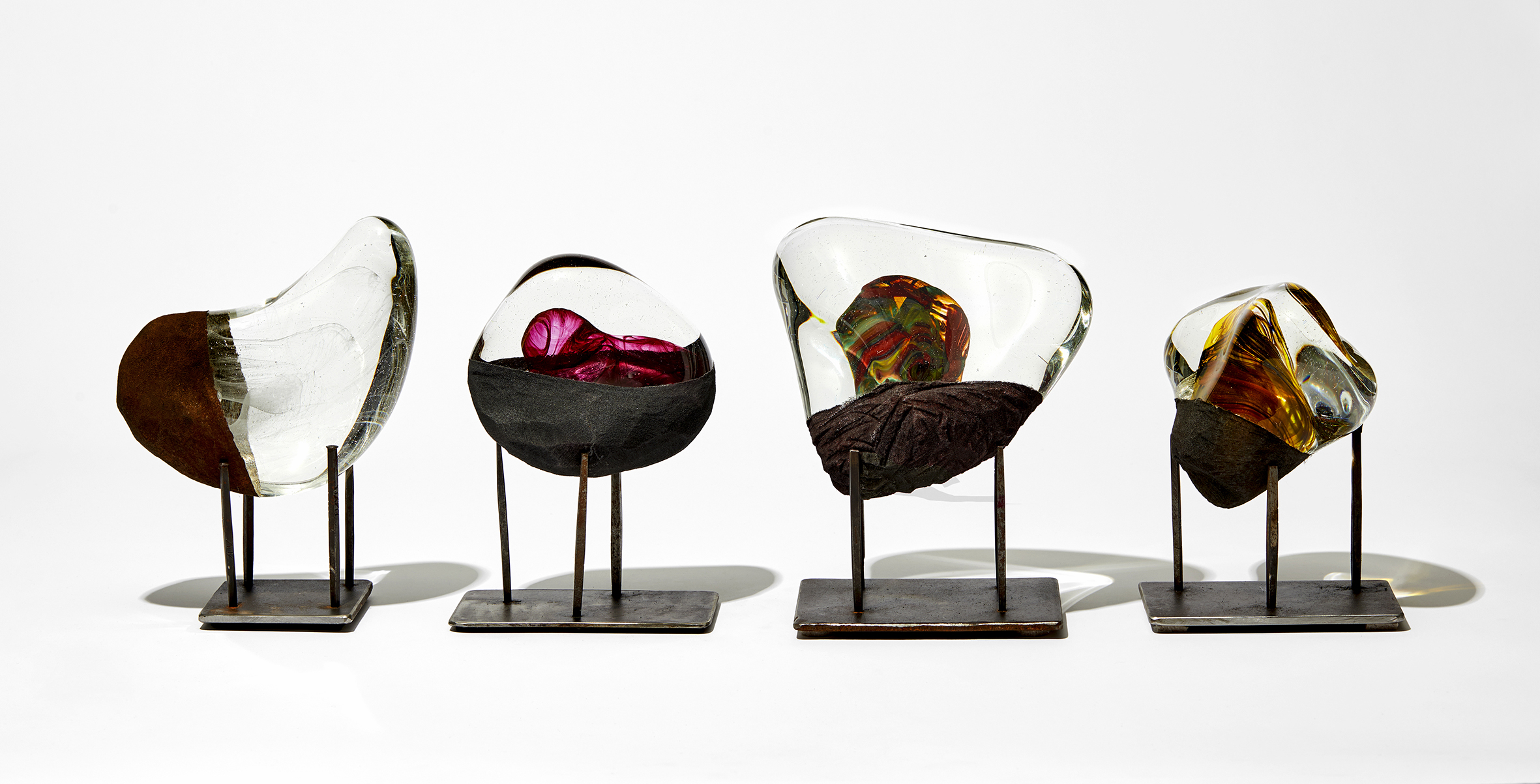
Meteorites Series
2022 | H 18cm x W 60cm x D 12cm | Hot glass, cold carved, sprk impregnated with iron and patinated | Photo by Agata Pec
Luminous Cold Mirrors
In the Parndon Mill studio, Jon Lewis has felt the freedom to concentrate more on his own oeuvre. When asked how he feels his work has developed over time, he pauses for a solemnly pensive moment. “It takes years to realize some of my work. I create something as a sketch or a glass maquette, and it may take five or ten years to decide how the piece should move forward. During my time in Oregon, we worked a lot with dichroic glass, adding glass sheets with a thin dichroic film to blown glass vessels. I was inspired by the dichroic glass, because it is so versatile. I brought this knowledge home to England with me and started creating 25-mm-thick glass blocks with dichroic in the centre that could be used for building. The blocks looked amazing. Not shiny, glittery and garish, it was more technical than that for me. Interestingly, what we know as modern dichroic glass was actually developed from research into optical filters by NASA.”
Optically speaking, dichroic filters work in a similar way to an oil film on water. Part of the light spectrum is reflected from the top surface of the oil, and the other is reflected from the bottom surface where the oil meets the water. “I love working with dichroic glass. After the dichroic blocks, I started forging pieces I like to call Moon-rocks, which emanate an ethereal glow. I started making those in 1997, and I still make them today. In fact, I won an award for them at the 2022 British Glass Biennale in Stourbridge from the Worshipful Company of Glass Sellers.”
Jon Lewis is a glassblower by trade, but his Moon-rocks, for example, are created using numerous glass techniques including solid working in the hotshop, sandcasting, and kilncasting. “There are 140,000 of my luminous pebbles in the foyer of the Wellcome Collection in London.” The Wellcome trust supports discovery research into life, health, and well-being worldwide. “I worked on this nine-story-high sculpture of designer and architect Thomas Heatherwick. We created a cascading hanging piece suspended by wires called Bleigiessen, which means lead pouring in German, and the piece is a scaled model of the way hot lead takes its shape when poured into water.”
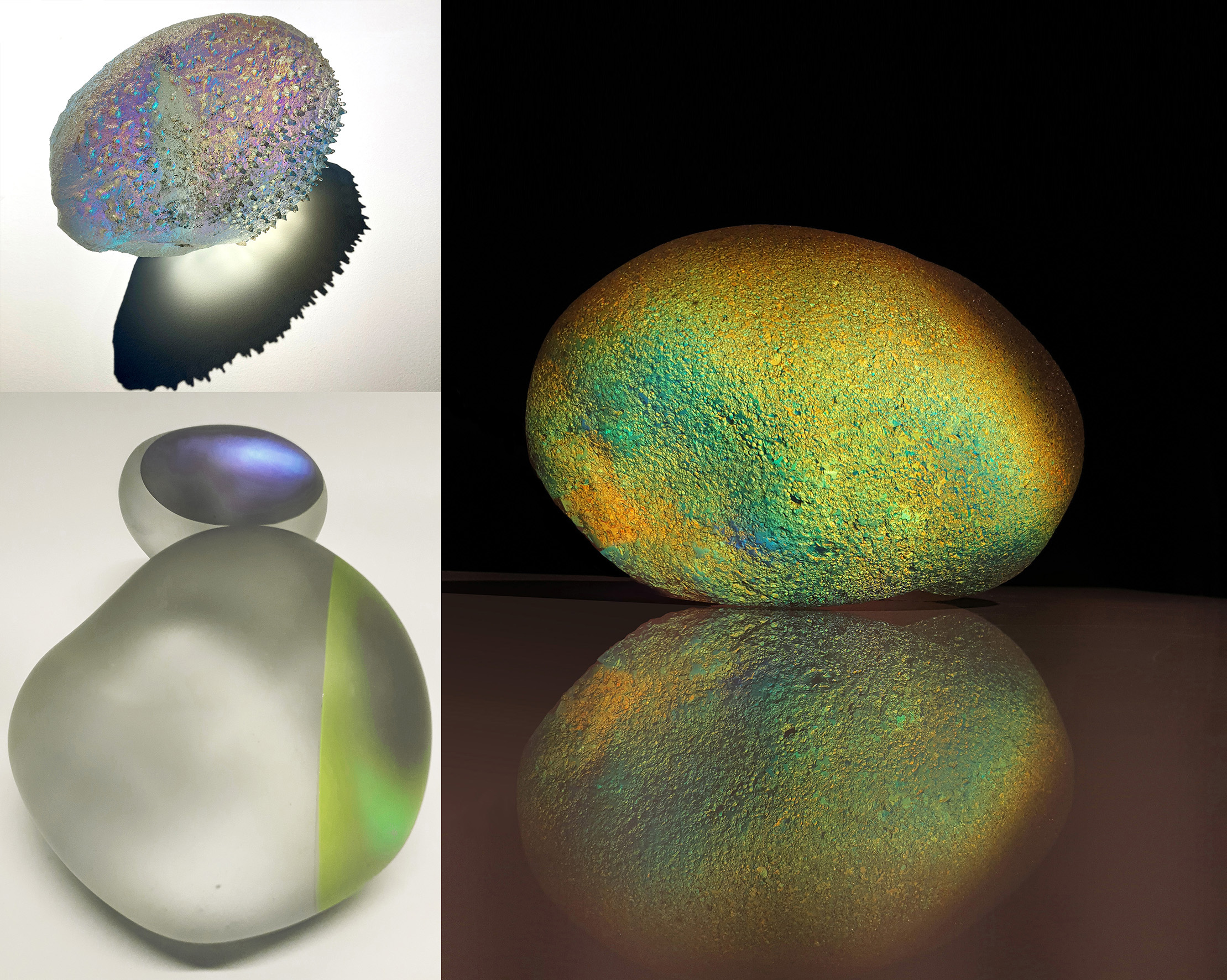
Top left:
Moon-rock
2022 | H 30cm x W 44cm x D 32cm | Hot cast glass, cold carved and with interference filter | Photo by Jon Lewis
Right:
Gold Moon-rock
2021 | H 28cm x W 44cm x D 32cm | Hot cast glass, cold carved and hand chipped surface with interference filter | Photo by Jon Lewis
Bottom left:
Lime & Violet Moon-rocks
2020 | H 20cm x W 18cm x D 12cm | Hot sculpted glass, cut, ground, interference dichroic filters | Photo by Jon Lewis
Selectively Passing While Reflecting
Jon uses techniques that he has developed himself in much of his work. “A recurring theme in my work has been the synthesis of glass with metal, using a self-developed technique called spark impregnation. I create my vessels by recycling television glass in the furnace. Once my work has cooled down safely and is annealed, I intensely grind iron and other metals, creating myriad small, hot, airborne particles that bond and ultimately cover the surface of my glass. I patinate this metallic layer to age and weather the exterior.”
Jon Lewis’ series Apertura is a visual allegory decrying the Second Life we virtually live in, through our smart technology. The artist recently had an exhibition at Vessel Gallery in London, which he entitled Distant Electric Vision. Before television was invented, a Scottish electrical engineer named A.A. Campbell Swinton wrote to the magazine Nature in 1908 describing his thoughts on how, with the use of cathode rays, distant electric vision would be possible. Swinton’s recognition of the possibilities of cathode rays is oftentimes cited as the critical discovery that made television possible. “Although I have a story to convey concerned with making the most of the natural world around us, I also enjoy simultaneously referencing the material history of my rescue vessels.”
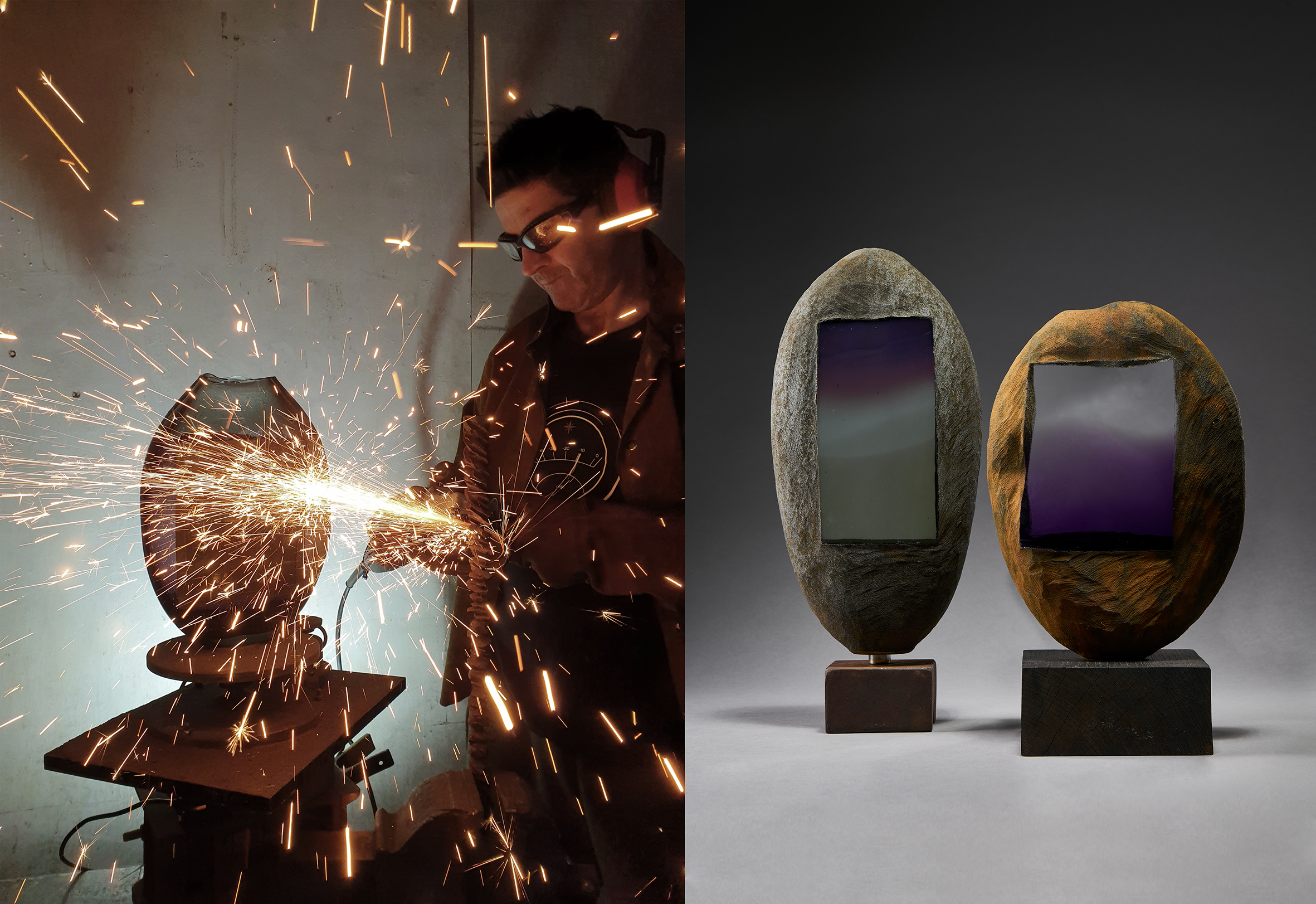
Above left:
The artist's technique of 'spark impregnation' in action
Above right:
Aurora Apertura
2019 | H 35cm x W 40cm x D 16cm | Recycled blown glass television screens, cold carved, spark impregnated with iron, patinated | Photo by Matthew Booth
In terms of theme, Jon enjoys experimenting with his material, from his glowing rocks to his iron-encrusted vessels. “I ask my audience to question if the work is even glass? What is it they are perceiving? Is it an object from another planet, an artefact, a feature of the past, or remains dug up from the sod? I want to create something that excites me, and this means if I make something too often, I am compelled to modify it and evolve the design to move them closer to their Platonic aesthetic.”
To shed some light on the concept of the Platonic form, we must travel to ancient Greece. The Greek philosopher Plato (428-7 BC to 348-7 BC) describes in numerous dialogues the Theory of Forms or the Allegory of the Cave, which asserts that the changing physical realm we inhabit is merely a flawed shadow of the universal ideal. In this realm, form (the universal) is a knowable, abstract, perfect, unchanging concept that transcends time and space. Purity in art is a goal many artists strive to embody, and Lewis’s vessels resonate with confident simplicity. “My Aperturas didn’t happen overnight. They took years to reach an essence of form that sang to my soul.”
Differing Wavelengths
As the series Apertura and Moon-rocks come to a close for now, Jon is developing a new body of work that fuses the historic with the futuristic. “I find steam trains fascinating. I imagine the breakthroughs of engineering during the Industrial Revolution, and I fantasize over an alternative future. By combining beautiful pieces of engineering from a bygone age with glass antennae permeated with dichroic radiance, I am creating hybrid solar vehicular entities.”
Creating a dichroic film on glass is a highly technical process. Metal oxides need to be deposited onto plate glass in a vacuum chamber. The 30 to 50 layer deposition needed measures 800 nanometers (30 millionths of an inch) and creates an optical interference filter. Dichroic filters produce a white light reflection, which with the human eye, is perceived as highly saturated in color. “The fusion of old and new unites my personal visual aesthetic with my needs as an inventor. As my hybrid solar glass engines develop, the contrast in power types feel like an experiment that has gone awry, and that makes me smile.”
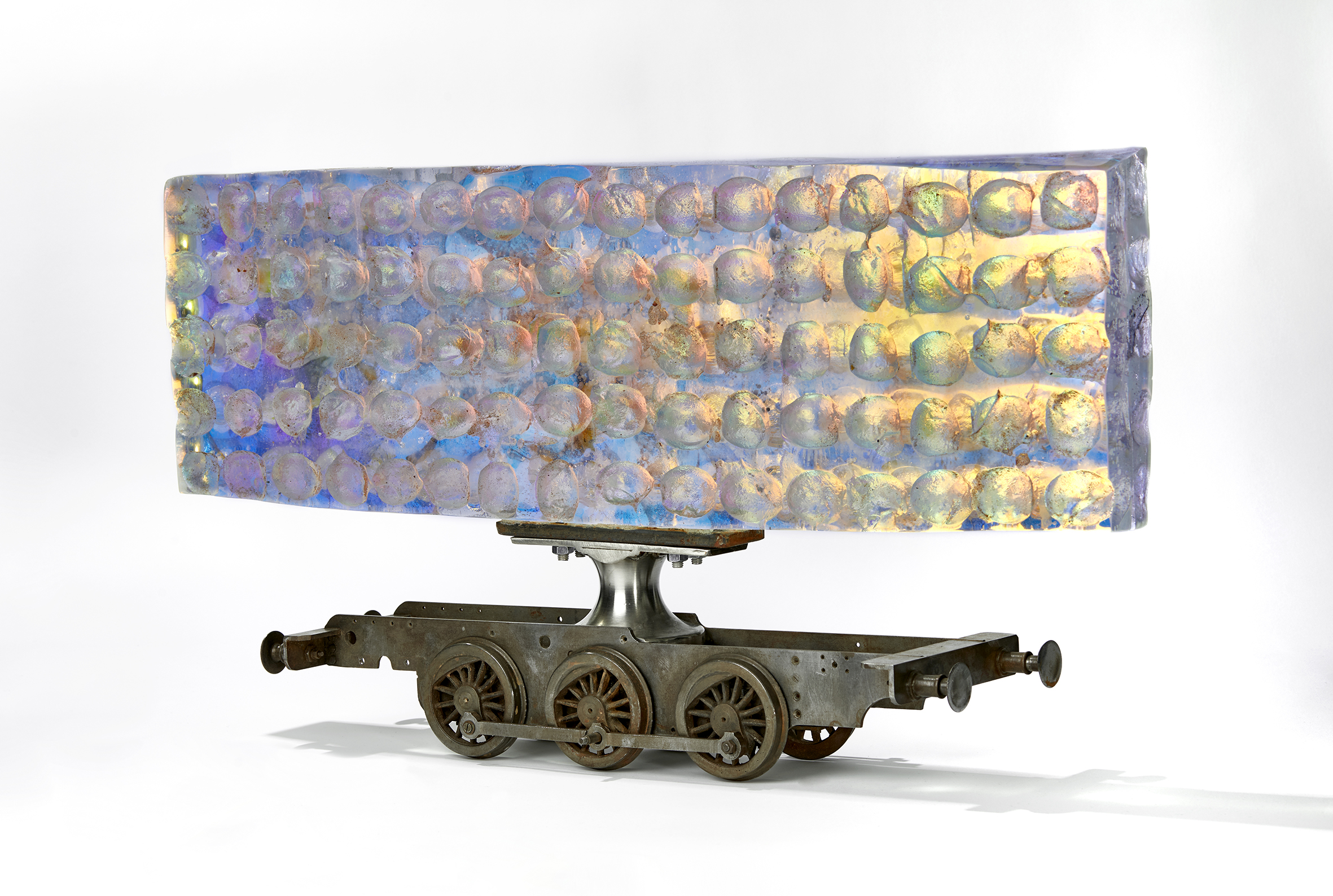

Top:
Icaron
2021 | H 40cm X W 74cm X D 16cm | Sand-cast glass, polished with interference filter, 3.5 inch gauge steam locomotive adapted rolling chassis | Photo by Agata Pec
Bottom left:
Icaron 3
2022 | H 45cm x W 74cm x D 16cm | Sand-cast glass, polished with interference filter, 3.5 inch gauge steam locomotive adapted rolling chassis | Photo by Jon Lewis
Bottom right:
Rolling Stock
2021 | H 20cm x W 60cm x D 16cm | Sand-cast glass, polished with interference filter, 3.5 inch gauge steam locomotive adapted rolling chassis | Photo by Agata Pec
About the Artist
Jon Lewis splits his time between gallery work, commissions, and teaching. He was awarded the Glass Society Prize in the British Glass Biennale 2019. Transceiver (pictured below) received an Honorable Mention in Trace – Showcasing Sustainable Glass Art in the Glass Art Society’s 2021 Conference. His dichroic glass has been used in numerous prestigious architectural commissions, and his work is in the permanent collection of the Glasmuseum Lette in Coesfeld, Germany.
Further artworks by Jon Lewis
Distant Electric Vision Solo Exhibition by Jon Lewis | Exhibition catalogue
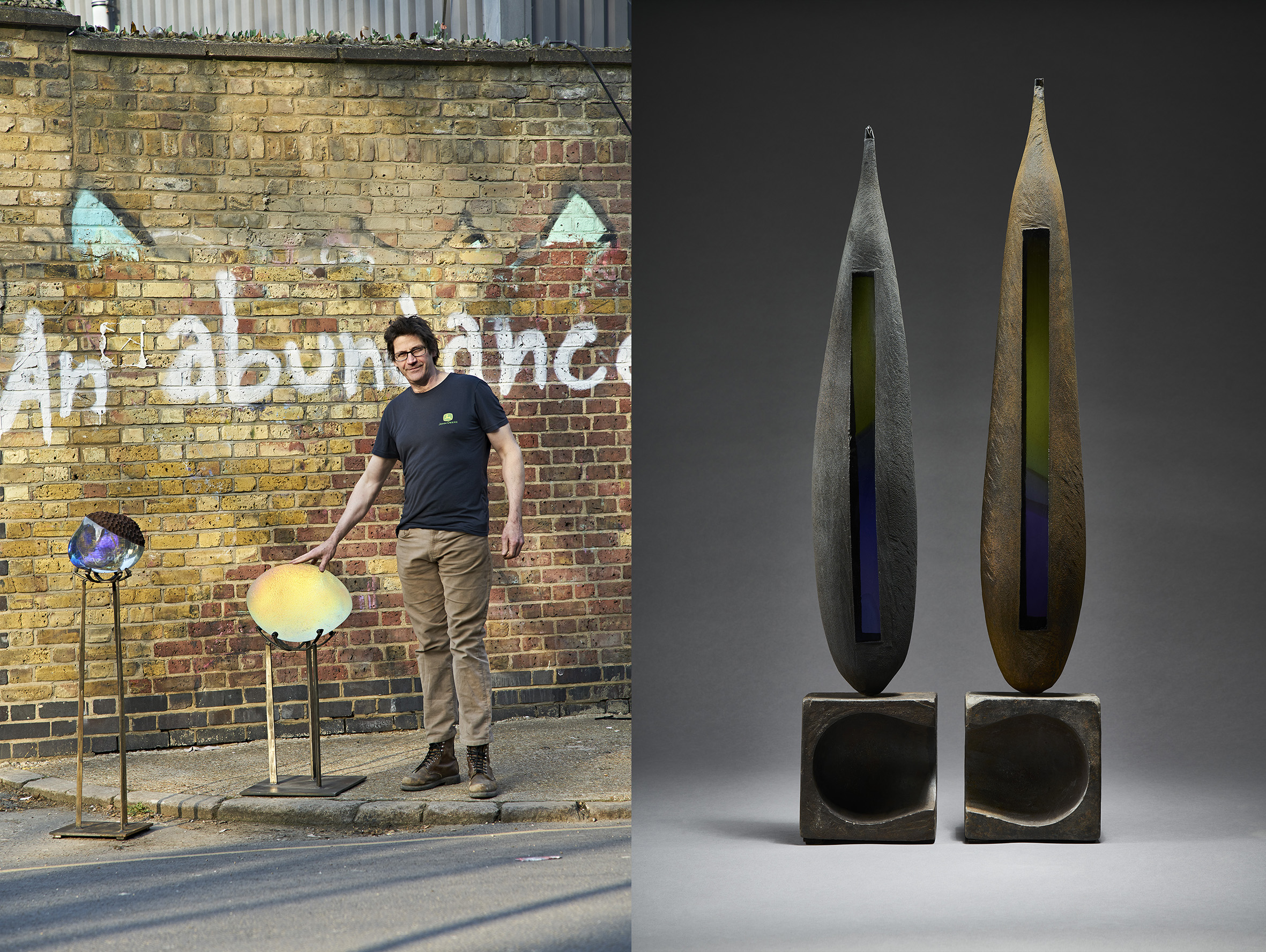
Above left:
Jon Lewis | Photo by Matthew Booth
Above right:
Transceiver
2020 | H 70cm x W 40cm x D 16cm | Recycled blown glass television screens, cold carved, spark impregnated with iron, patinated. Cast Iron bases | Photo by Matthew Booth
About the Author
Dr. Julie Anne Denton received her doctorate in the combination of sandcast and flameworked glass for artists in 2017. She has been schooled in the Italian flameworking tradition and has worked alongside some of the best flameworking and sandcasting artists of the day. Her key artistic themes are people, folklore, nature and culture. Julie Anne has received worldwide recognition for her storytelling skills as an artist and writer, and her technical skills as a glassmaker.
© Copyright 2023 by Glass Art® Jan/Feb edition | All rights reserved.
Below:
Ice Moon-rock
2021 | H 40cm x W 40cm x D 30cm | Sand-cast glass, ground, polished with interference filters | Photo by Jon Lewis
